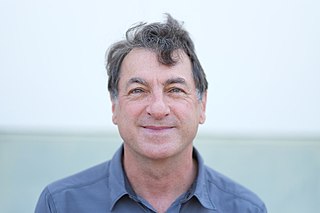Related Research Articles
Supersymmetry is a theoretical framework in physics that suggests the existence of a symmetry between particles with integer spin (bosons) and particles with half-integer spin (fermions). It proposes that for every known particle, there exists a partner particle with different spin properties. There have been multiple experiments on supersymmetry that have failed to provide evidence that it exists in nature. If evidence is found, supersymmetry could help explain certain phenomena, such as the nature of dark matter and the hierarchy problem in particle physics.
R-parity is a concept in particle physics. In the Minimal Supersymmetric Standard Model, baryon number and lepton number are no longer conserved by all of the renormalizable couplings in the theory. Since baryon number and lepton number conservation have been tested very precisely, these couplings need to be very small in order not to be in conflict with experimental data. R-parity is a symmetry acting on the Minimal Supersymmetric Standard Model (MSSM) fields that forbids these couplings and can be defined as

Nathan "Nati" Seiberg is an Israeli American theoretical physicist who works on quantum field theory and string theory. He is currently a professor at the Institute for Advanced Study in Princeton, New Jersey, United States.
In theoretical physics, soft SUSY breaking is type of supersymmetry breaking that does not cause ultraviolet divergences to appear in scalar masses.
Savas Dimopoulos is a particle physicist at Stanford University. He worked at CERN from 1994 to 1997. Dimopoulos is well known for his work on constructing theories beyond the Standard Model.

Jonathan Richard "John" Ellis is a British-Swiss theoretical physicist.
Igor R. Klebanov is an American theoretical physicist. Since 1989, he has been a faculty member at Princeton University where he is currently a Eugene Higgins Professor of Physics and the director of the Princeton Center for Theoretical Science. In 2016, he was elected to the National Academy of Sciences. Since 2022, he is the director of the Simons Collaboration on Confinement and QCD Strings.
In particle physics, the lightest supersymmetric particle (LSP) is the generic name given to the lightest of the additional hypothetical particles found in supersymmetric models. In models with R-parity conservation, the LSP is stable; in other words, it cannot decay into any Standard Model particle, since all SM particles have the opposite R-parity. There is extensive observational evidence for an additional component of the matter density in the universe, which goes under the name dark matter. The LSP of supersymmetric models is a dark matter candidate and is a weakly interacting massive particle (WIMP).
The history of string theory spans several decades of intense research including two superstring revolutions. Through the combined efforts of many researchers, string theory has developed into a broad and varied subject with connections to quantum gravity, particle and condensed matter physics, cosmology, and pure mathematics.

Sunil Mukhi is an Indian theoretical physicist working in the areas of string theory, quantum field theory and particle physics. Currently he is Adjunct Professor at the International Centre for Theoretical Sciences of the Tata Institute of Fundamental Research and Honorary Professor Emeritus at the Indian Institute of Science Education and Research, Pune.

Mikhail "Misha" Arkadyevich Shifman is a theoretical physicist, formerly at the Institute for Theoretical and Experimental Physics, Moscow, currently Ida Cohen Fine Professor of Theoretical Physics, William I. Fine Theoretical Physics Institute, University of Minnesota.

Gian Francesco Giudice is an Italian theoretical physicist working at CERN in particle physics and cosmology.

Riccardo Barbieri is an Italian theoretical physicist and a professor at the Scuola Normale Superiore di Pisa. He has written more than two hundred research papers in the field of theoretical elementary particle physics, and has been particularly influential in physics beyond the Standard Model.
Stuart Samuel is a theoretical physicist known for his work on the speed of gravity and for his work with Alan Kostelecký on spontaneous Lorentz violation in string theory, now called the Bumblebee model. He also made significant contributions in field theory and particle physics.

Yasunori Nomura is a theoretical physicist working on particle physics, quantum gravity, and cosmology. He is a professor of physics at University of California, Berkeley, a senior faculty scientist at Lawrence Berkeley National Laboratory, a senior research scientist at Riken, and an affiliate member at Kavli Institute for the Physics and Mathematics of the Universe. Since 2015, he has been the director of the Berkeley Center for Theoretical Physics.
Peter Christopher West, born on 4 December 1951, is a British theoretical physicist at King's College, London and a fellow of the Royal Society.
Michael Dine is an American theoretical physicist, specializing in elementary particle physics, supersymmetry, string theory, and physics beyond the Standard Model.

Mark John Bowick is a theoretical physicist in condensed matter theory and high energy physics. He is the deputy director of the Kavli Institute for Theoretical Physics at the University of California, Santa Barbara, and a Visiting Distinguished Professor of Physics in UCSB's Physics Department.
Hermann Nicolai is a German theoretical physicist and director emeritus at the Max Planck Institute for Gravitational Physics in Potsdam-Golm.
Vernon Duane Barger is an American theoretical physicist, specializing in elementary particle physics.
References
- 1 2 3 4 "Martin Einhorn". Kavli Institute for Theoretical Physics, U. of California, Santa Barbara.
- ↑ "Physics Tree – Marvin Leonard Goldberger". academictree.org. Retrieved 2021-03-07.
- ↑ "Martin B. Einhorn, Faculty History Project". lib.umich.edu, U. of Michigan.
- ↑ "INSPIRE". inspirehep.net. Retrieved 2021-03-07.
- 1 2 "DPF Newsletter – July 1, 1994 – American Physical Society, DPF Elections, Martin Einhorn, University of Michigan" (PDF). aps.org (Division of Particles and Fields).
- ↑ "Martin B. Einhorn". John Simon Guggenheim Memorial Foundation.